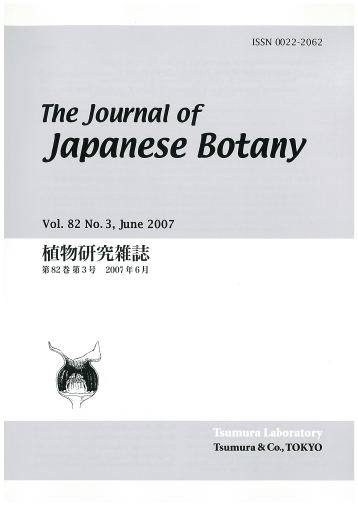
- Issue 6 Pages 321-
- Issue 5 Pages 251-
- Issue 4 Pages 179-
- Issue 3 Pages 117-
- Issue 2 Pages 57-
- Issue 1 Pages 1-
- |<
- <
- 1
- >
- >|
-
Article type: cover
2007Volume 82Issue 3 Article ID: 82_3_9962
Published: June 20, 2007
Released on J-STAGE: October 20, 2022
JOURNAL FREE ACCESSDownload PDF (1394K) -
Satoshi SHIMADA, Tomoya TADANO, Jiro TANAKAArticle type: Originals
2007Volume 82Issue 3 Pages 117-125
Published: June 20, 2007
Released on J-STAGE: October 20, 2022
JOURNAL FREE ACCESSA new species, Codium tenuifolium Shimada, Tadano & J. Tanaka, is described from the Pacific coast of Japan. It is characterized in having thin blades, clavate utricles with tumid head and vegetative reproductive structures. In phylogenetic analysis of the sequences of the chloroplast encoded rbcL gene, C. tenuifolium formed a monophyletic clade with C. latum Suringar (with 69 % bootstrap support). The pairwise distance between them is 17 bp (2.6 %). Codium tenuifolium is morphologically distinguished from C. latum by almost simple and thinner thallus, shorter and broader clavate utricles.
View full abstractDownload PDF (526K) -
Machiko TSUSAKA, Hiroshi IKEDA, Takuji HOSHINOArticle type: Originals
2007Volume 82Issue 3 Pages 126-129
Published: June 20, 2007
Released on J-STAGE: October 20, 2022
JOURNAL FREE ACCESSA new species, Codium tenuifolium Shimada, Tadano & J. Tanaka, is described from the Pacific coast of Japan. It is characterized in having thin blades, clavate utricles with tumid head and vegetative reproductive structures. In phylogenetic analysis of the sequences of the chloroplast encoded rbcL gene, C. tenuifolium formed a monophyletic clade with C. latum Suringar (with 69 % bootstrap support). The pairwise distance between them is 17 bp (2.6 %). Codium tenuifolium is morphologically distinguished from C. latum by almost simple and thinner thallus, shorter and broader clavate utricles.
View full abstractDownload PDF (410K) -
Kazumi FUJIKAWA, Yoko KITA, Hideaki OHBAArticle type: Originals
2007Volume 82Issue 3 Pages 130-136
Published: June 20, 2007
Released on J-STAGE: October 20, 2022
JOURNAL FREE ACCESSSaussurea yakla was described by Clarke (1876), and Lipschitz (1979) placed this species in sect. Cyathidium of subgen. Saussurea based on the large size of its capitula and pinnatisect leaves. However, the chromosome number 2n = 34 reported for the species is consistent with those of other members of Himalaiella, and the results of a phylogenetic analysis revealed that S. yakla is nested within Himalaiella. In addition Saussurea yakla is characterized by having 4-5-gonal, rugose pericarps with an irregularly toothed crown and uniform pappus arranged in a single row. These characters are also shared with the genus Himalaiella. The results of the molecular phylogenetic, cytological and morphological analyses all support a transfer of Saussurea yakla to the genus Himalaiella. A new combination, Himalaiella yakla, is made here.
View full abstractDownload PDF (477K) -
Kazukiyo HASEGAWA, Jiro TANAKAArticle type: Originals
2007Volume 82Issue 3 Pages 137-144
Published: June 20, 2007
Released on J-STAGE: October 20, 2022
JOURNAL FREE ACCESSReproductive structures of Dictyopteris latiuscula from the Pacific coast of Kanto, Japan and reproductive seasonality in Shimoda, Shizuoka Pref. were studied. This is the first report of female gametophytes and oogonia of the species. Mature sporophytes and gametophytes were simultaneously collected in late spring to early summer. Reproductive season of the species was differed between Chiba and Shizuoka.
View full abstractDownload PDF (561K) -
Bin YE, Hiroyoshi OHASHIArticle type: Originals
2007Volume 82Issue 3 Pages 145-159
Published: June 20, 2007
Released on J-STAGE: October 20, 2022
JOURNAL FREE ACCESSPollen grains of nine of the 14 species of the genus Hylodesmum were examined by scanning and transmission electron microscopy mostly for the first time. They share commonly characteristics in the structure of exine, i. e., thick endexine, densely columellate infratectum and discontinuous foot layer. Most of the species have tricolpolate, prolate spheroidal to subprolate and fine-rugulate to microreticulate pollen grains. However, pollen grains of H. oldhamii are deviated in the sculpture and structure of the exine from the common pattern and those of H. repandum in the pollen type and shape.
View full abstractDownload PDF (941K) -
Yutaka SASAKI, Hiroyoshi OHASHIArticle type: Originals
2007Volume 82Issue 3 Pages 160-174
Published: June 20, 2007
Released on J-STAGE: October 20, 2022
JOURNAL FREE ACCESSKoelreuteria paniculata Laxm. has been regarded in different views as a species imported from China or as an indigenous species to Japan. Based on extensive field work we found many natural populations of the species in northeastern Miyagi Prefecture. We recognized K. paniculata is wild and native in these habitats. Natural populations of the species occupy an almost uniform condition. Their habitats are mostly in natural Zelkova serrata forests developed on stony and poorly soiled cliffs facing east to south along coasts and along the river Kitagami-gawa in Miyagi Prefecture. Wild populations of K. paniculata in Japan are also recognized as indigenous based on examination of herbarium specimens and references or records of the species in each localities. They occur sporadically in the following prefectures from northeast to west: Aomori, Akita, Iwate, Miyagi, Yamanashi, Nagano, Ishikawa, Fukui, Hyogo, Shimane, Yamaguchi and Nagasaki (Tsushima). Flowers of K. paniculata are bright yellow, but we found plants with pale yellow flowers in four populations in Miyagi Prefecture. The form is recognized at the rank of forma as K. paniculata f. miyagiensis H. Ohashi & Yu. Sasaki.
View full abstractDownload PDF (1147K) -
Yu IOKAWA, Hiroyoshi OHASHIArticle type: Notes
2007Volume 82Issue 3 Pages 175-177
Published: June 20, 2007
Released on J-STAGE: October 20, 2022
JOURNAL FREE ACCESSDownload PDF (451K) -
Article type: Errata
2007Volume 82Issue 3 Pages 177
Published: June 20, 2007
Released on J-STAGE: October 20, 2022
JOURNAL FREE ACCESSDownload PDF (392K) -
[in Japanese]Article type: Book review
2007Volume 82Issue 3 Pages 178
Published: June 20, 2007
Released on J-STAGE: October 20, 2022
JOURNAL FREE ACCESSDownload PDF (394K) -
[in Japanese]Article type: Book review
2007Volume 82Issue 3 Pages 178
Published: June 20, 2007
Released on J-STAGE: October 20, 2022
JOURNAL FREE ACCESSDownload PDF (394K)
- |<
- <
- 1
- >
- >|